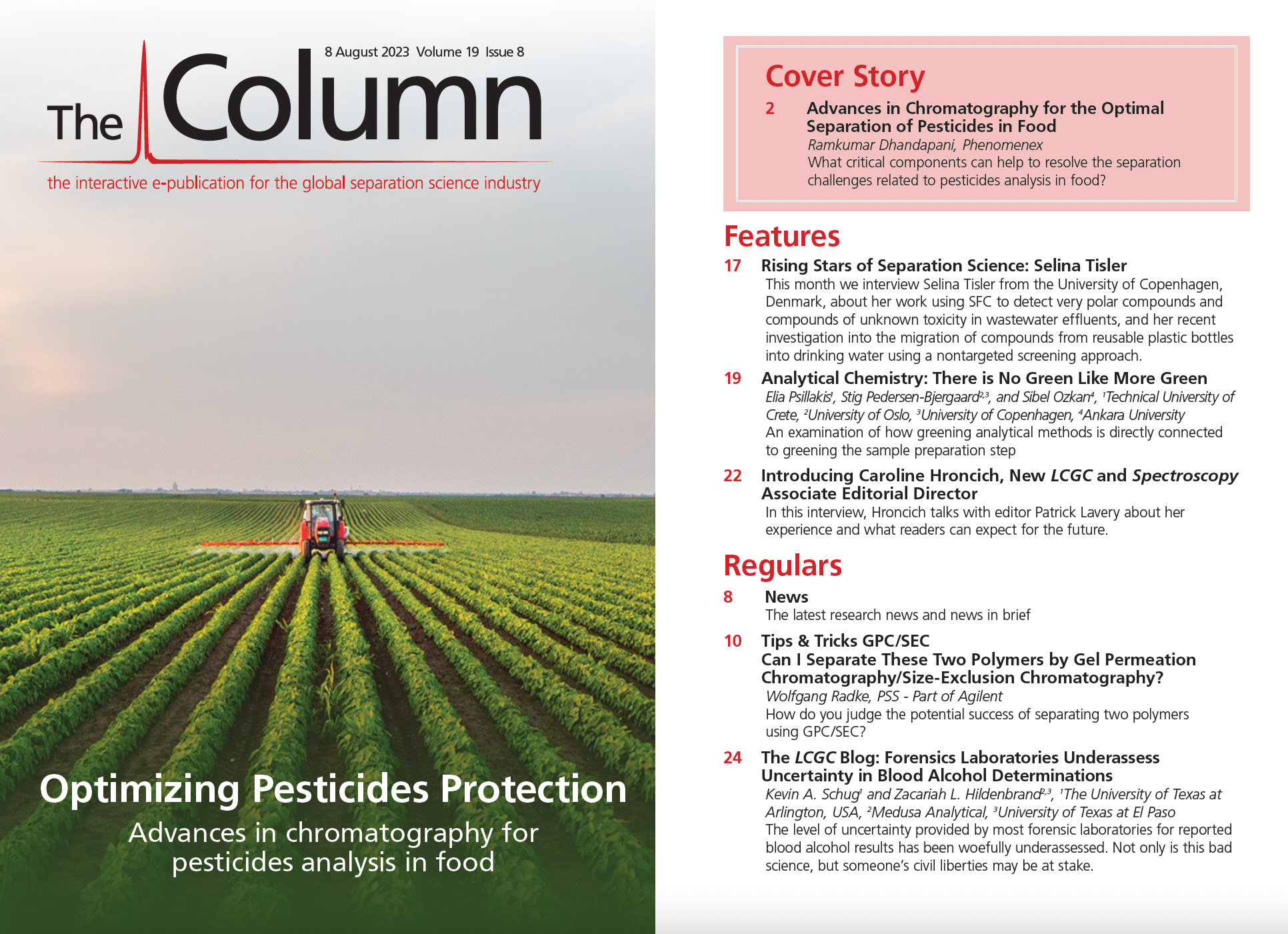Advances in Chromatography for the Optimal Separation of Pesticides in Food
Pesticides analysis in food presents various challenges, including meeting regulatory guidelines, critical pair resolution, retention and recovery, matrix interference, and meeting sensitivity requirements. Above all, the ever‑growing list of pesticide compounds and the high throughput needed to pass or fail an increasing number of samples each day encourages scientists to explore a combination of sample preparation techniques, separation techniques, and detectors to achieve and exceed goals. This article will review these critical components that can eventually resolve the separation challenges related to pesticides analysis in food.
To establish the safety of our food, toxic and harmful chemicals in food and beverages must be measured before consumption. To understand the safe levels of these multiresidue compounds, scientists require appropriate sample extraction, separation, and detection techniques to accurately identify and quantify these compounds. Safe levels are set by governmental agencies, and maximum residue levels (MRLs) are commonly referred to as the upper limits of what is allowable to the general public. This ensures that our food stays safe for consumption.
Tractor spraying soybean field in sunset | Image Credit: © Dusan Kostic - stock.adobe.com

Sample Preparation for Multiresidue Pesticides Analysis
With diverse limits of detection, the large number of pesticides and other contaminants that need to be analyzed creates a challenge for gas chromatography (GC) analysis. Before analysis can take place, the complex and often dirty matrices in food samples, such as proteins, fats, and pigments, mean that laboratories need to adopt accurate sample preparation methods to remove unwanted matrix components. While there are several sample preparation options available for pesticides extraction from food, a simple sample preparation method can save laboratories time in the downstream and save them from having to re-run data. Even with the additional method development and time spent on cleanup, the benefits are numerous. In multiresidue analysis of food, QuEChERS (Quick, Easy, Cheap, Effective, Rugged, Safe) is a popular technique and combines extraction and clean-up steps. This technique provides optimal recovery by extracting everything from the matrix and then removing matrix components, including fats and pigments, to provide a cleaner extract and higher recovery for multipesticide classes in a single extract (1). There are guidelines from official methods, such as AOAC official method 2007.01 and EN 15662 QuEChERS method, that begin with the extraction of pesticides from food samples using acetonitrile, which makes the method optimization and selection of QuEChERS easier (2,3). In fact, the extract from QuEChERS can be utilized for liquid chromatography (LC) and GC analysis with minimal modification. A good example explaining the versatility of this extraction is presented in reference 4 (Figures 1 and 2).
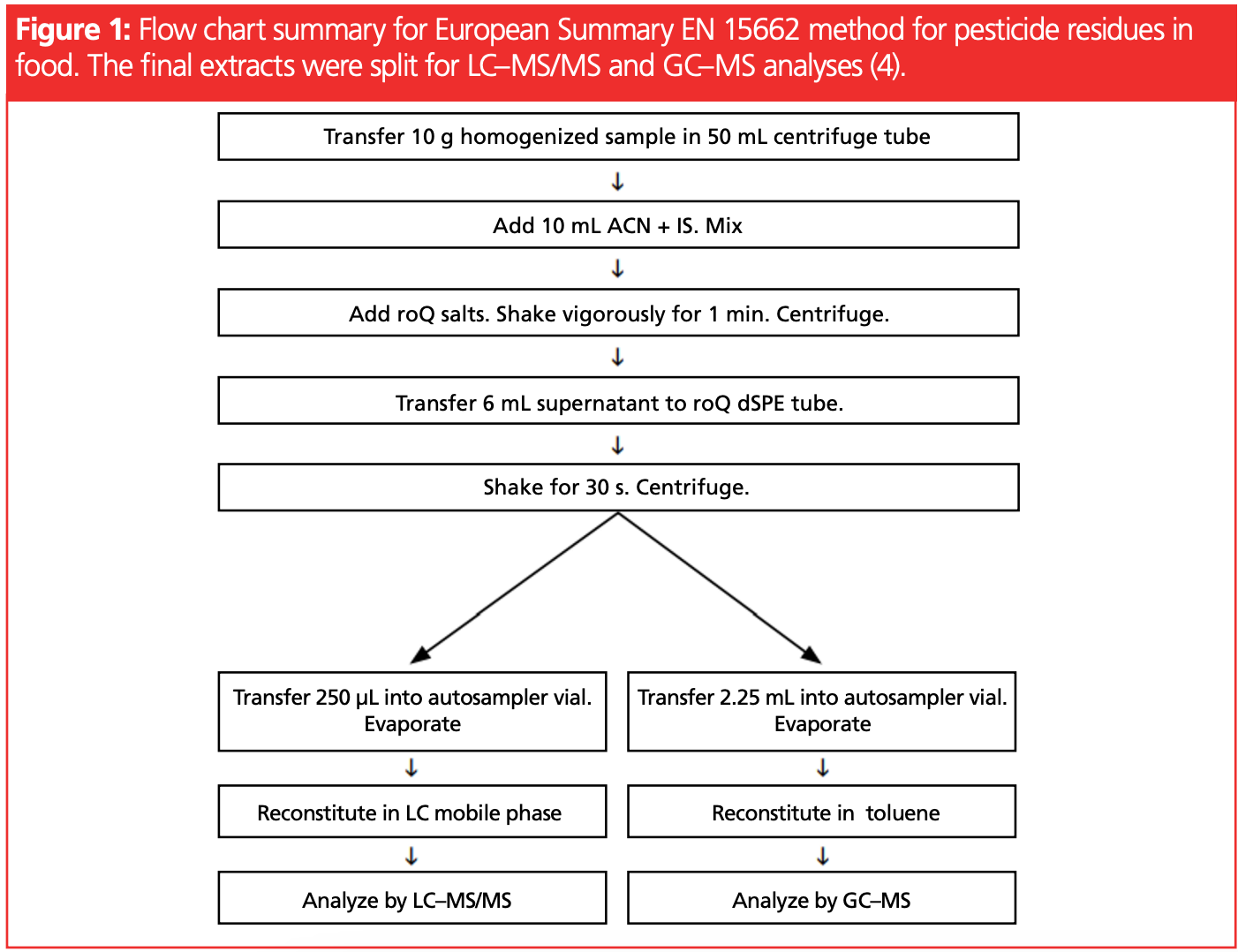
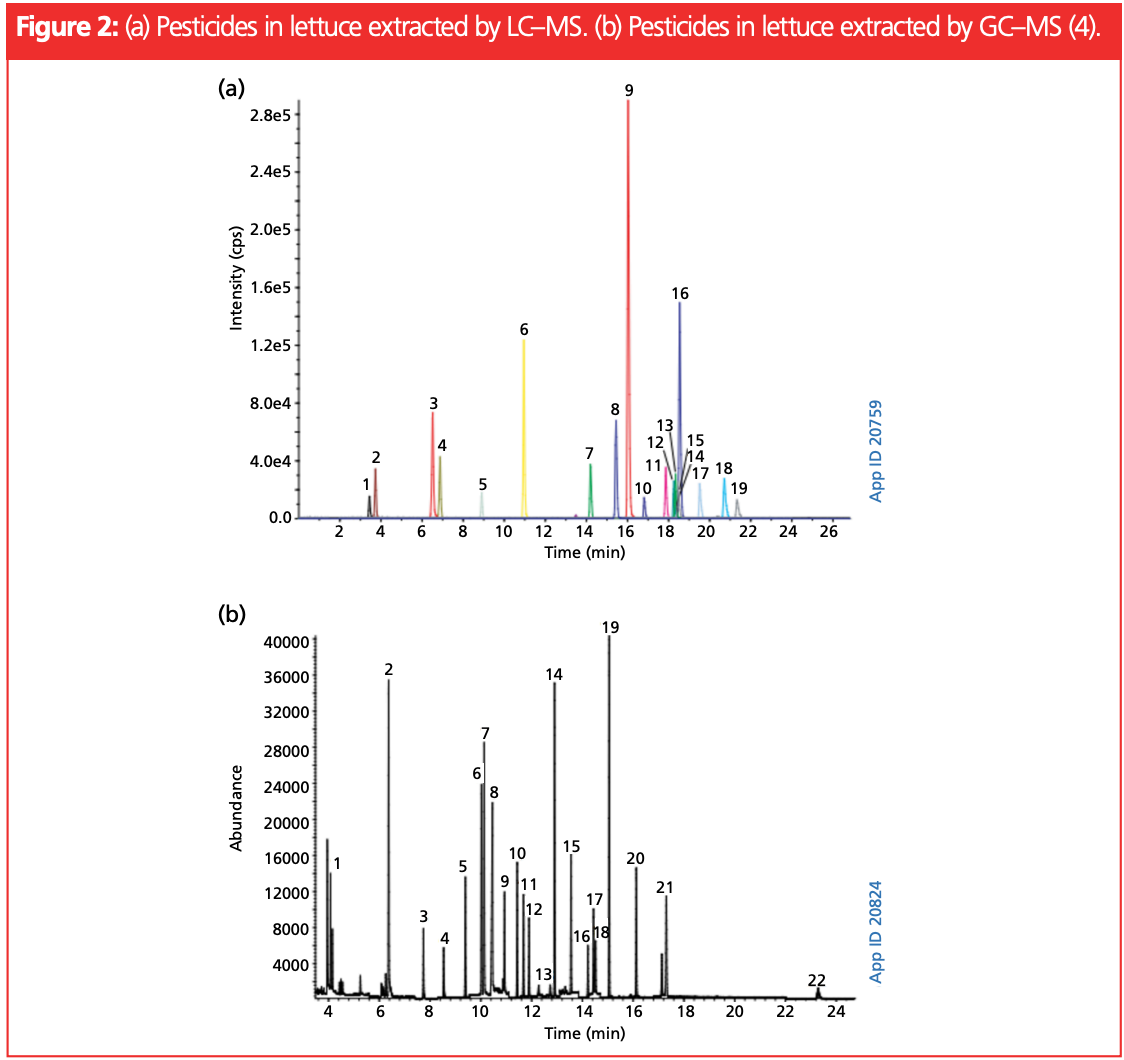
GC vs. LC for Multiresidue Pesticides
While both LC and GC have their advantages for pesticides analysis, LC is the “go to” choice for underivatized nonvolatile pesticides, as well as temperature-sensitive semivolatile pesticides. Within the list of pesticides analyzed by LC, polar pesticides (cationic and anionic pesticides) require specialty columns to achieve the desired separation and detection needs. Groups of pesticides analyzed by GC include nonionic and volatile to semivolatile classes; these can extend from a few pesticides to a few hundred pesticides. With GC, the analyte eluting out of the column is in its gaseous form and is easily ionizable in a mass spectrometer. Because of this, and due to the strong ionization of the commonly used electron ionization (EI)-mass spectrometer, almost all GC pesticides achieve good ionization, which eventually translates to peak response. While some pesticides may pose challenges in electrospray ionization (ESI)—a source commonly used in LC–mass spectrometry (MS)—polarity switching and alternative ionization can be used as a mitigation for challenging analytes in LC–MS. Irrespective of LC vs. GC, analytical techniques are complementary and utilize orthogonal separation and detection of trace pesticide compounds, which can collectively solve the detection and quantification of pesticides to increase confidence in the safety of food.
GC Column Considerations for Pesticides Analysis
The chromatographic GC column is considered to be the heart of the separation in a GC instrument. The pesticides are partitioned between the mobile phase and stationary phase film to realize chromatographic separation. This is commonly directed by the vapour pressure of the individual pesticide compound and the selectivity of the GC stationary phase. There are multiple factors to consider before settling on a GC stationary phase for pesticides. This includes identifying the ideal stationary phase selectivity, optimal dimension, and the most inert stationary phase that can reduce breakdown of challenging analytes.
Figure 3 presents a separation of a list of pesticides on three different column selectivities. As is common in multiresidue analysis, certain pesticides may be too polar and may not wet traditional 5MS columns, which are low-polar stationary phase. Mid-polar stationary phases specially designed for multiresidue analysis can eliminate the dewetting of polar pesticides and can therefore give sharper peaks for both polar and nonpolar pesticides. It is therefore important to screen a few mid-polar selectivities before settling on a 5MS-based column for pesticides analysis. Online column selection tools are useful in making the correct stationary phase selection (5).
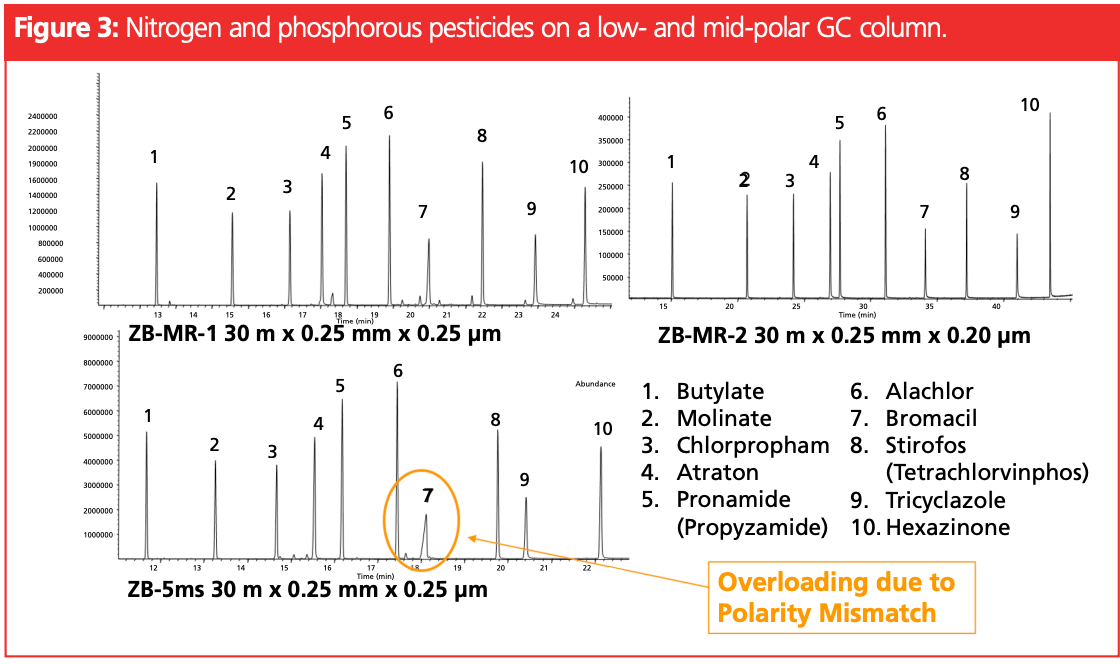
While most modern methods in GC use MS-based detection, shorter columns ranging from 10 m to 15 m in length with an inner diameter of 0.1 mm to 0.25 mm are optimal for fast and robust analysis of pesticides. While a 30 m length is still considered for traditional GC–flame ionization detection/ electron capture detection (FID/ECD) methods, when considering the mass spec aspect and the throughput that laboratories demand, shorter columns are preferred for multiclass pesticides.
Another important consideration is the selection of an inert stationary phase surface with minimal active spots, as these spots can break down heat-sensitive pesticides such as dichlorodiphenyltrichloroethane (DDT) and endrin.
LPGC for Fast Pesticides Analysis
Low-pressure GC–MS (LPGC–MS) is a technique that uses the MS vacuum system, along with a specially designed column setup with a shorter length and larger inner diameter in combination with a restrictor column for flow maintenance, to lower the pressure inside the GC column. By reducing the pressure inside the column and eventually the viscosity, the analysis is expedited up to threefold with minimal compromise in resolution. This technique has found immense popularity by improving throughput in food testing laboratories (6).
GC–MS for Pesticides
While GC remains the most cost-efficient way to detect pesticides, adding an additional dimension of separation with a quadrupole mass spectometer increases the authenticity of detection. With appropriate sample clean-up and preconcentration, multiclass pesticides analysis can be reliably performed on a benchtop GC–MS system. The retention profile of over 100 pesticides has been reported on a novel GC column selectivity for accurate identification and quantification of these residues (7). Sharper peak shape, chromatographic resolution, and low bleed from modern GC columns can help to lower the noise level and improve detection, thereby making complex multiresidue analysis an affordable option.
GC–HRMS for Pesticides
While GC–MS provides separation and detection across many industries, tandem mass spectrometry (MS/MS) is used to add the extra robustness and sensitivity that is usually required for large panels of pesticide analytes. Another advancement that is recommended for optimization is high-resolution MS; this technique can help in the detection and quantitation of pesticides in complex food matrices better than triple quadrupole (QqQ) mass spectrometry due to high-resolution accurate mass that is utilized for quantification. To understand this method better, 285 pesticides from several food matrices were optimized on a GC–high-resolution mass spectrometry (HRMS) system (8). HRMS instruments offer great capability for identification of compounds thanks to the measurement of accurate mass. In this sense, the combination of GC with HRMS is a very powerful tool, with nominal spectral libraries for screening and authentication. Figure 4 presents the separation of key pesticides by GC–HRMS on a 5% phenyl-arylene GC column. Sharp peaks, adequate chromatographic separation, and accurate mass for quantification with HRMS helps to achieve low detection limits for a wide range of pesticides.
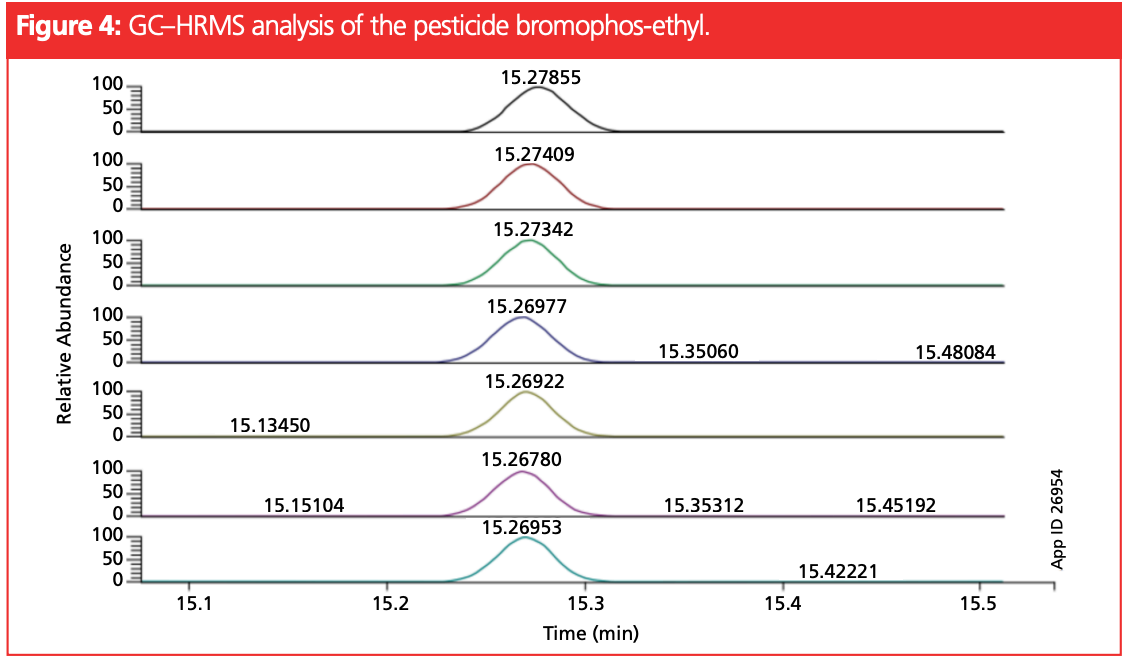
GC–MS/MS for Pesticides Analysis
GC–MS/MS, also called GC–QqQ, has an impressive noise level improvement and filtration and improved detection levels for multipesticide residue analysis. Due to the selective nature and advanced engineering design of various triple quadrupole instruments that are available, ultra-trace levels of multicomponent detection are feasible. A detection limit of 5 parts per billion (ppb) was achieved for over 100 pesticides from olive oil, which is considered a very challenging matrix with GC–MS/MS analysis (9). Aside from the detection, modern triple quadrupole instruments are relatively compact and have advanced automated method optimization options, helping to facilitate fast method development and optimization.
Conclusion
Sample preparation offers preconcentration and matrix removal to obtain a cleaner extract for introduction on to the chromatographic system. Following this, choosing a column with an inert surface and optimal selectivity provides chromatographic resolution and high accuracy. Depending on the matrix complexity, instrument availability, and the detection levels, various detector choices including GC–MS, GC–MS/MS, and GC– HRMS are available for quantification of multiresidue pesticides from food matrices. These techniques work in combination to improve the quality of pesticides analysis and increase the confidence in results.
References
(1) Lehotay, S. J.; de Kok, A.; Hiemstra, M.; van Bodegraven, P. Validation of a Fast and Easy Method for the Determination of Residues from 229 Pesticides in Fruits and Vegetables Using Gas and Liquid Chromatography and Mass
Spectrometric Detection. JAOAC Int. 2005, 88 (2), 595–614. DOI: 10.1093/jaoac/88.2.595
(2) Lehotay, S. J.; Son, K. A.; Kwon, H. Comparison of QuEChERS Sample Preparation Methods for the Analysis of Pesticide Residues in Fruits and Vegetables. J. Chromatogr. A 2010, 1217, 2548–2560. DOI: 10.1016/j.chroma.2010.01.044
(3) https://www.eurl-pesticides.eu/userfiles/file/EurlSRM/EurlSrm_Observations_AcidicPesticides.pdf
(accessed 2023-07-21).
(4) https://phx.phenomenex.com/lib/tn97851012_W.pdf (accessed 2023-07-14).
(5) https://www.phenomenex.com/tools/gc-column-finder (accessed 2023-07-14).
(6) Sapozhnikova, Y. Evaluation of Low-Pressure Gas Chromatography–Tandem Mass Spectrometry Method for the Analysis of >140 Pesticides in Fish. J. Agric. Food Chem. 2014, 62 (17), 3684–3689. DOI: 10.1021/jf404389e
(7) https://phenomenexcn.blob.core.chinacloudapi.cn/documents/7ccfef00-afa5-4fdc-a71f-ff479b36757d.pdf (accessed 2023-07-14).
(8) https://www.phenomenex.com/documents/2022/05/20/19/15/development-of-a-new-analytical-method-for-determining-pesticide-residues-by-gas-chromatographyhigh (accessed 2023-07-14).
(9) https://www.phenomenex.com/documents/2022/05/20/18/53/gc-msms-analysis-of-pesticides-in-extra-virgin-olive-oil (accessed 2023-07-14).
About the Author
Ramkumar Dhandapani has been in the chromatography industry for over 20 years and has hands-on and troubleshooting experience. He has a masters and PhD degree in analytical chemistry from Seton Hall University, with specialization in microextractions, multidimensional chromatography, and tandem MS techniques. He has developed and validated several regulatory compliant methods in the pharmaceutical, food, fuels, and the environmental industry, as well as incorporated method improvement and troubleshooting across a range of separation techniques. He joined Phenomenex in August 2014 and currently works as a senior product manager. In addition to managing the product line, he presents on innovations in separation science at various chromatography conferences. Direct correspondence to: ramkumard@phenomenex.com
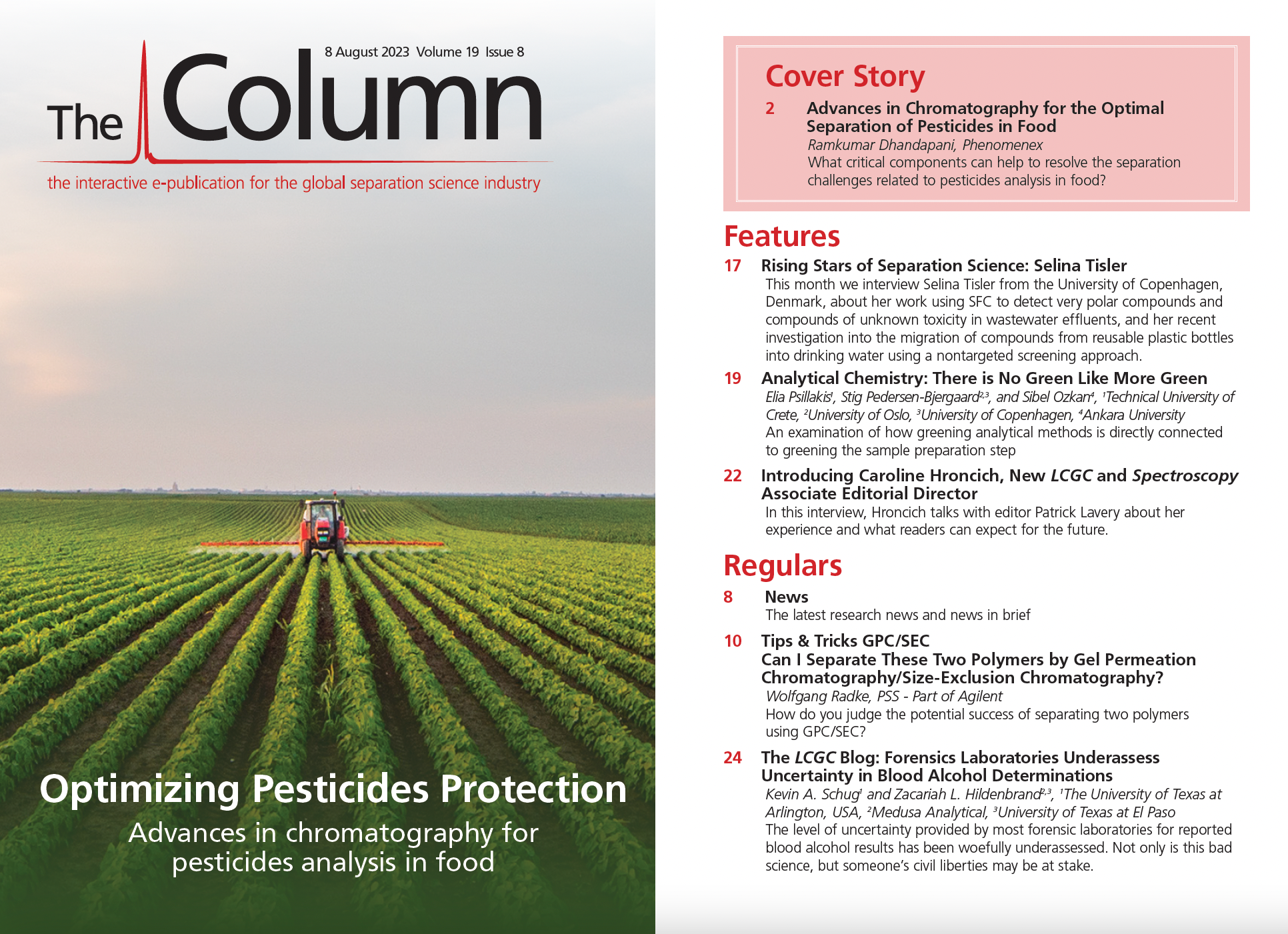
Analytical Challenges in Measuring Migration from Food Contact Materials
November 2nd 2015Food contact materials contain low molecular weight additives and processing aids which can migrate into foods leading to trace levels of contamination. Food safety is ensured through regulations, comprising compositional controls and migration limits, which present a significant analytical challenge to the food industry to ensure compliance and demonstrate due diligence. Of the various analytical approaches, LC-MS/MS has proved to be an essential tool in monitoring migration of target compounds into foods, and more sophisticated approaches such as LC-high resolution MS (Orbitrap) are being increasingly used for untargeted analysis to monitor non-intentionally added substances. This podcast will provide an overview to this area, illustrated with various applications showing current approaches being employed.
New Study Reviews Chromatography Methods for Flavonoid Analysis
April 21st 2025Flavonoids are widely used metabolites that carry out various functions in different industries, such as food and cosmetics. Detecting, separating, and quantifying them in fruit species can be a complicated process.

.png&w=3840&q=75)

.png&w=3840&q=75)



.png&w=3840&q=75)



.png&w=3840&q=75)








